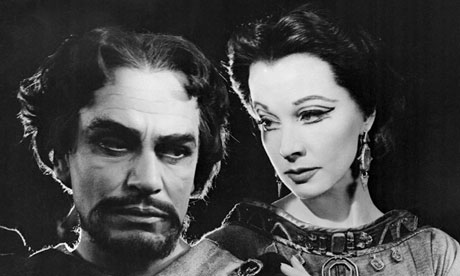
For more than 50 years it has been one of the great questions of British cinema: what would the celebrated actor and director Laurence Olivier have done with Shakespeare's Macbeth if he had managed to make a big-screen version?
Olivier, who was bitterly disappointed when his attempt to film the play was scuppered by financial problems, tried to shroud the project in mystery during his lifetime, saying there were no surviving copies of his screenplay and teasing fans and critics that nobody would ever have any idea how his version would have compared with those of Orson Welles or Roman Polanski.
But now an academic searching for something quite different has stumbled upon 13 versions of the lost screenplay among papers and discovered that Olivier had some surprises in store.
For example, Olivier and his then wife Vivien Leigh were to play Macbeth and Lady Macbeth, but also two of the three witches. Olivier planned to cut out the famous "Is this a dagger which I see before me?" line to make Macbeth seem more heroic and in an early draft Lady Macbeth was to suffer a miscarriage, which does not happen in the play but did befall Leigh in real life.
Macbeth was going to be Olivier's fourth cinematic adaptation of Shakespeare following successful versions of Hamlet, Henry V and Richard III. He and Leigh had starred in a much lauded production of Macbeth in Stratford-upon-Avon in 1955 and Olivier was keen to adapt it for the cinema.
But the project was shelved in 1958, mainly because of financial problems, and Olivier later claimed there were no surviving scripts, only a "sketch". Since then the lost project has been seen as a gap in British cinema history and fed into the idea of the "Scottish play" as an unlucky one.
More than half a century later, it fell to Jennifer Barnes, a 31-year-old English lecturer from Exeter University, to provide some of the answers. She was going through papers for research on Olivier's film version of Richard III in the manuscripts reading room at the British Library when she came across references to Macbeth scripts.
"I was going through the catalogues and I pulled up a script and found it was Macbeth. I didn't believe it because I knew it wasn't supposed to exist." The papers were part of an archive bought for £1m by the library from Olivier's family in 2000. "I guess the people who catalogued them didn't know how important they were," Barnes said.
Olivier built up an air of mystery around Macbeth after failing to make the film, branding it an "impossible monster". "He created this aura of mystique around Macbeth," said Barnes. "I guess that is why everyone wants to know what it was like."
Rather than being just a "sketch", the scripts offered intricate timings, set plans and technical notes. There were early drafts through to detailed shooting scripts.
The screenplay opens not as the play does, with the three witches, but with an image of Macbeth gazing into a pit at a mortally wounded version of himself, "his blood colouring the water all around him". In the early part of the movie the misty landscapes (Olivier had planned to film on location in Scotland, and the script mentions Inverness, Skye and the village of Scone) provide a stark contrast to the solid castle interiors. Later the distinction becomes less strong as Olivier envisaged the damp fog invading the enclosed spaces and the greys giving way to reds as the action turns bloody.
At times Macbeth and Lady Macbeth morph into the witches and there is one shot in the script in which the Macbeth's head dissolves and transforms into the witches' cavern.
The biggest surprise, however, is the loss of part of Macbeth's "Is this a dagger?" speech. Olivier intended to miss out the opening lines and start the speech halfway through as Leigh's Lady Macbeth dips her hands in the dead king's blood. Olivier was not planning to show Macbeth carrying out the murder.
Barnes believes the screenplays shed an intriguing light on the relationship of Olivier and Leigh, which was breaking down by the late 50s. "One of the recurring stories was that Leigh was taking away Olivier's power, making him a lesser man. I think there is an emphasis on the breakdown of the Macbeths' marriage in the screenplay."
Other standout moments in Olivier's version include his imagining of the moment when Birnam Wood advances on Dunsinane.
The actor and director clearly expected something spectacular, warning the art department in a note: "Considerable tree cutting necessary for sequence."
Olivier's screenplay concludes with a spectacular fight between Macbeth and the man who vanquishes him, Macduff. Olivier wrote: "Every conceivable trick of fighting that isn't going to get a laugh must be employed."

